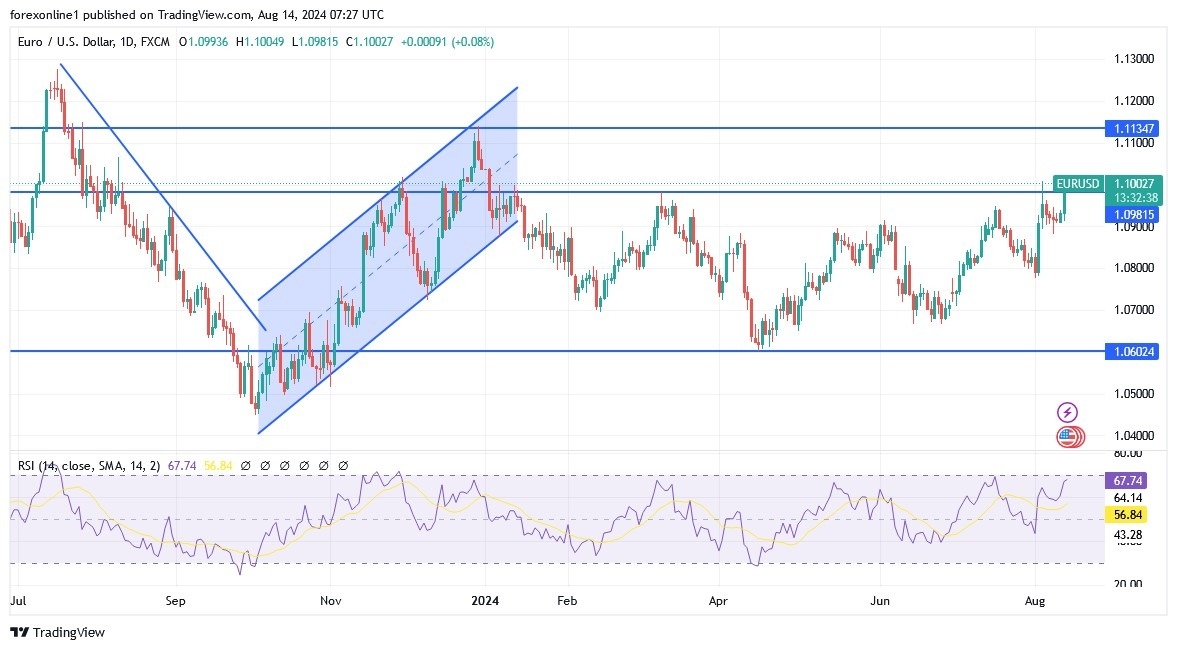EUR/USD Analysis: Euro Nears Seven-Month High
- Amidst a bullish momentum supported by the decline in US inflation figures, the EUR/USD currency pair has returned to the psychological resistance level of 1.1000, bolstering the dominance of bulls.
- This marks the highest level for the currency pair in seven months, driven by the weakening of the US dollar following the release of lower-than-expected US producer price index data.
(Click on image to enlarge)
These data had boosted investors’ confidence that the Federal Reserve may soon start cutting US interest rates. However, a survey revealed weaker-than-expected investor confidence in Germany, which often indicates broader trends in the eurozone. According to the economic calendar, the ZEW economic sentiment index for Europe’s largest economy fell by 22.6 points in one month to 19.2 points, well below expectations of 32. Since Monday, investors have slightly increased their expectations for two interest rate cuts by the European Central Bank by its meeting in mid-October.
Start Trading Now With The World's Best Trading Platform!
Prior to this, the Euro, which had recently risen to a seven-month high of $1.10, was facing downward pressure, trading around $1.092. Meanwhile, investors are monitoring the European Central Bank's monetary policy, with expectations of potential interest rate cuts fueling concerns. Economists suggest that the ECB may implement a series of quarterly deposit rate cuts until late next year, possibly concluding the easing cycle earlier than expected.
Furthermore, the speculation has sparked renewed focus on the euro’s future trajectory amid growing economic uncertainty.
ECB Rate Cut Expectations
In this regard, economic analysts expect the European Central Bank to cut its benchmark interest rate by six-quarters of a percentage point, which could lead to a reduction to 2.25% by December 2025. Thus, this timetable represents a significant acceleration compared to previous expectations, which expected such cuts by mid-2026. The ECB began the process of cutting interest rates in June, with the aim of returning inflation to its 2% target. However, setting a specific timetable for these cuts remains difficult due to the ongoing economic uncertainty within the eurozone.
A Cautious Approach Amid Economic Uncertainty
Despite the possibility of further rate cuts, ECB officials have been reluctant to commit to a specific timetable. This caution stems from the ongoing economic challenges in the eurozone, particularly in Germany. Recent reports indicate a slowdown in private sector activity across the region, along with weak growth in Germany, the eurozone’s largest economy. As a result, experts have lowered their growth forecasts for the broader European economy, raising concerns about the effectiveness of potential interest rate cuts in stabilizing the region’s financial health.
Moreover, weak economic performance in the eurozone and Germany has sparked panic in global financial markets.
In general, investors are closely monitoring the potential implications for trade agreements, investment decisions, and overall market sentiment. The uncertainty surrounding the euro’s future, coupled with evolving economic indicators, is contributing to increased volatility in markets. Adding to the complexity, market participants are also focusing on the direction of US consumer prices. Any major shifts could prompt the Federal Reserve to consider cutting interest rates by 50 basis points in September.
Such a move by the Fed would further complicate the global economic landscape and could impact the performance of the euro against the US dollar.
Given that the Euro is facing changing monetary policies, economic concerns, and global market dynamics, increased volatility and uncertainty are expected. The complex interplay between central bank policies, economic performance, and investor sentiment will continue to shape the trajectory of the Euro in the coming months. To navigate these unstable conditions, stakeholders must stay informed about policy developments, market trends, and geopolitical influences that may affect future currency movements.
Tova Bukingolts
EUR/USD Technical analysis and forecast:
According to the performance on the daily attached, the EUR/USD price movement above the psychological resistance of 1.1000 will enhance bulls’ control and strengthen the upward trend. Furthermore, technical indicators will move towards strong overbought levels in case of moving towards the resistance levels of 1.1060 and 1.1120 respectively. On the other hand, and for the same time frame, the support level of 1.0820 will remain the most important to evaporate the current bullish hopes. Technically, the performance will remain subject to the reaction to the announcement of US inflation figures and statements by US Federal Reserve officials.
More By This Author:
Gold Price Analysis: Gold Price Stabilizes Near Record HighsUSD/JPY Analysis: Neutral Performance Awaits Any News
GBP/USD Analysis: Attempting To Break The Downtrend
Disclosure: DailyForex will not be held liable for any loss or damage resulting from reliance on the information contained within this website including market news, analysis, trading signals ...
more



